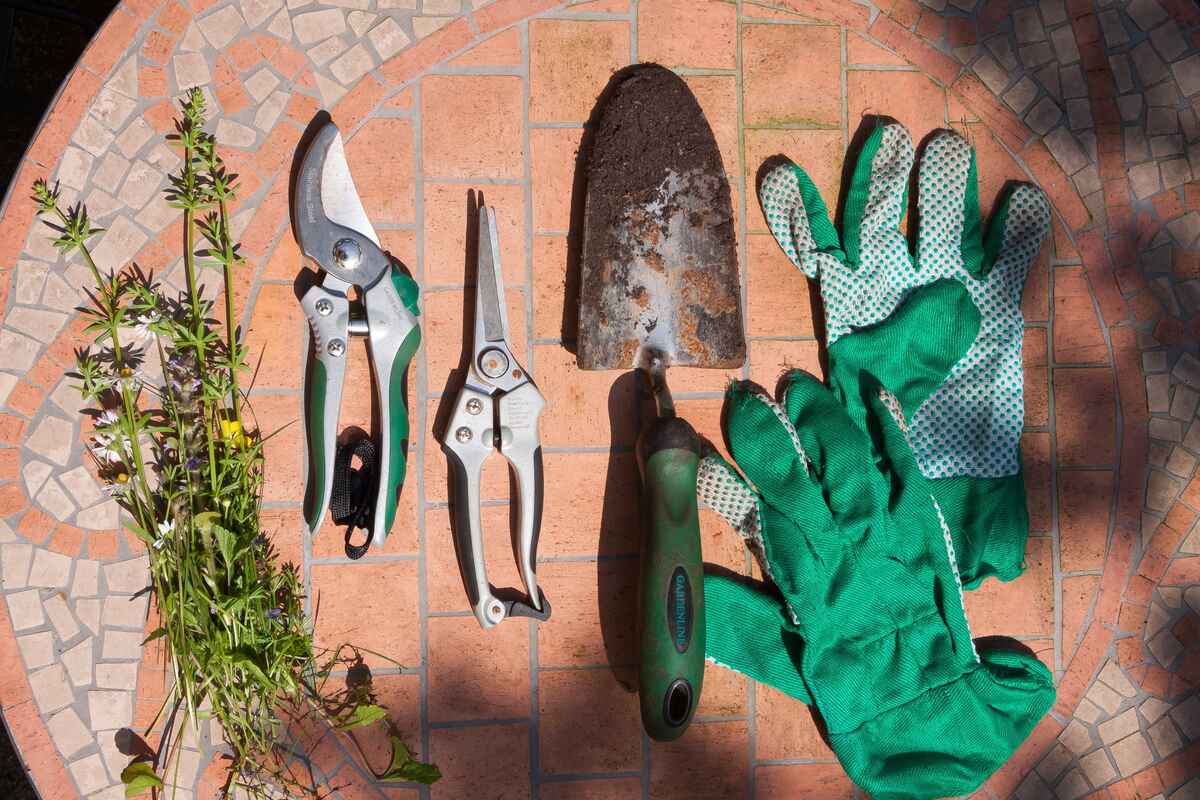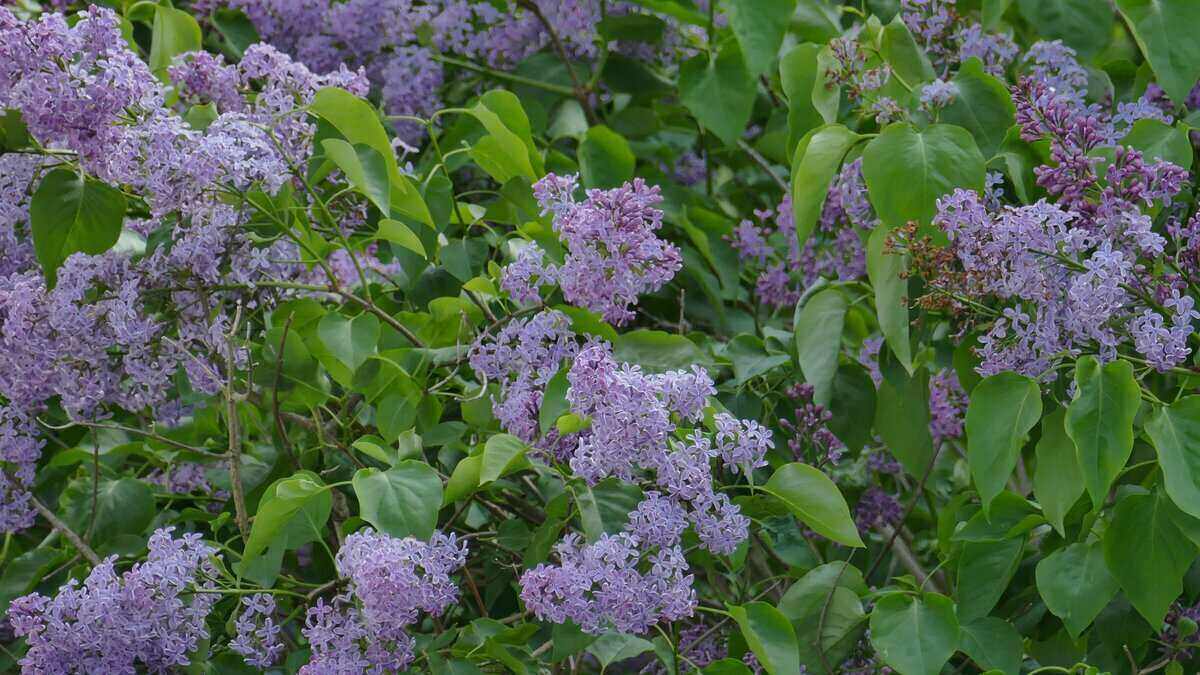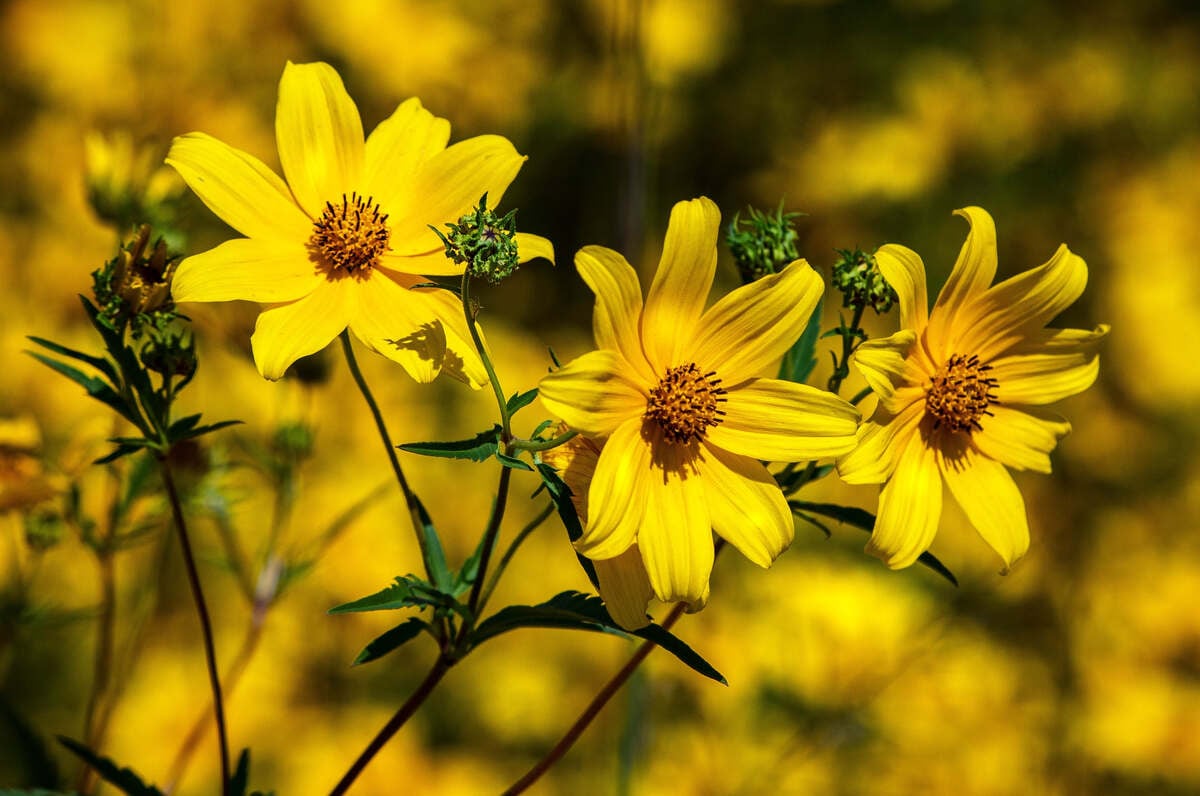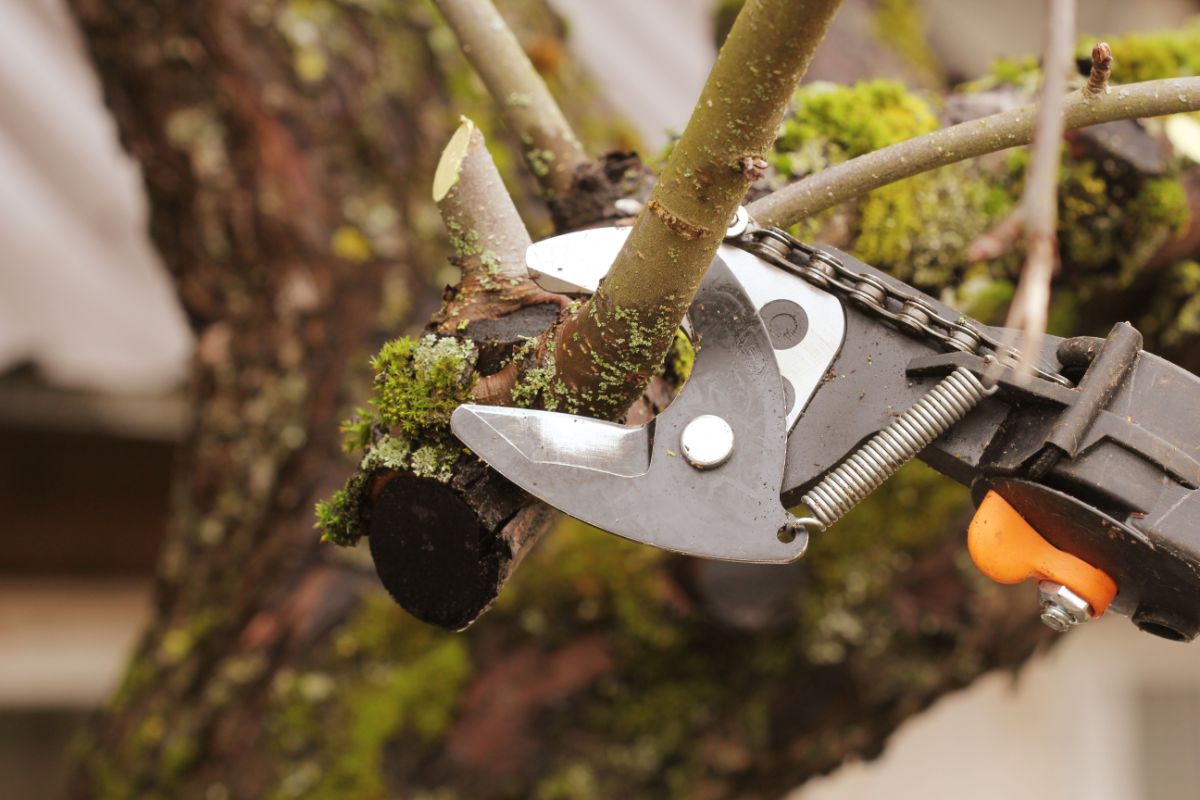
Pruning is a standard horticultural practice that selectively removes branches, stems, buds, or roots from plants. It is commonly performed on woody plants like trees, bushes, and shrubs to maintain or improve health, appearance, and productivity.
Pruning techniques vary depending on the plant species you’re working with and the desired outcome — surprisingly, there’s much more to it than hacking at your tree or shrub with shears or a saw. To achieve the results you want without compromising the plant’s health or structural integrity, it’s essential to follow some basic pruning practices.
10 Reasons to Prune Trees and Shrubs
Pruning is fundamental to caring for trees and shrubs in your landscaping. It has numerous health and aesthetic benefits.
- Maintain plant health and overall vigor.
- Stimulate new plant growth by removing old or unproductive branches.
- Enhance the overall appearance through shaping and changing undesirable growth patterns.
- Establish a robust and balanced structure in young trees.
- Control the size and density of the tree or shrub.
- Maximize flowering and fruit production.
- Create specialized forms such as espaliers, topiaries, and hedges.
- Rejuvenate old or overgrown shrubs or trees.
- Prevent the spread of disease to healthy parts of the plant and nearby trees or shrubs.
- Protect people and property from weak, rotted, or hazardous branches.
5 Rules of Pruning
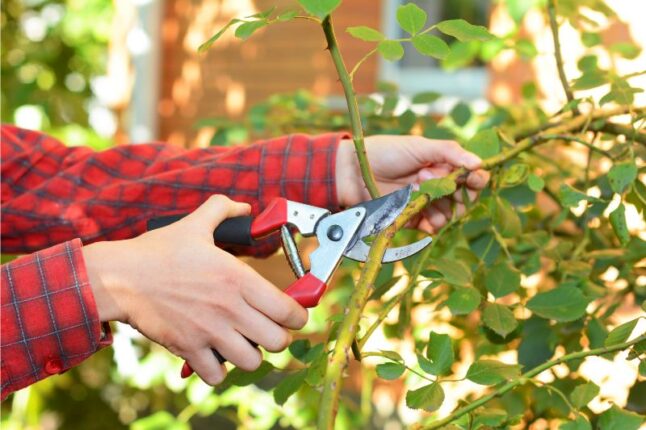
Know When to Prune
The most critical rule when pruning trees and shrubs is knowing the best time of year to prune. This timing depends on how your plant grows and if it flowers in the spring or summer.
- If your tree or shrub flowers before June 1, prune it immediately after flowering.
- If your shrub or tree blooms after June 1, prune it the following year, in late winter or early spring, before new flower buds develop.
- If your tree or shrub doesn’t flower, prune it during the dormant season, either in late fall or early spring.
Pro Tip: Never prune in late summer or fall if your tree or shrub is still growing. Pruning at this time in the season promotes tender new growth that may not be hardy enough to survive through a harsh winter.
Know Where to Cut
- ALWAYS make pruning cuts back to the soil line or just above a growing point on the branch.
- NEVER leave a branch or stem stub.
- NEVER top a tree to spur growth. It can harm and weaken the tree, cause it to grow wider, and send up water sprouts as an emergency response.
Remove Problematic Branches First
When you start pruning, the first step is to remove dead or dying branches and those that can wrap others. Even during dormancy, you can differentiate between live and dead limbs: live branches are more flexible and have a green layer under the bark; dead branches are brittle and don’t have a green layer.
You always want to remove branches growing in toward the middle of the tree or shrub, unwanted suckers growing at the base of the tree, water sprouts that are growing straight upward from dominant branches, and any branches with narrow angles.
Thin Out Dense Growth
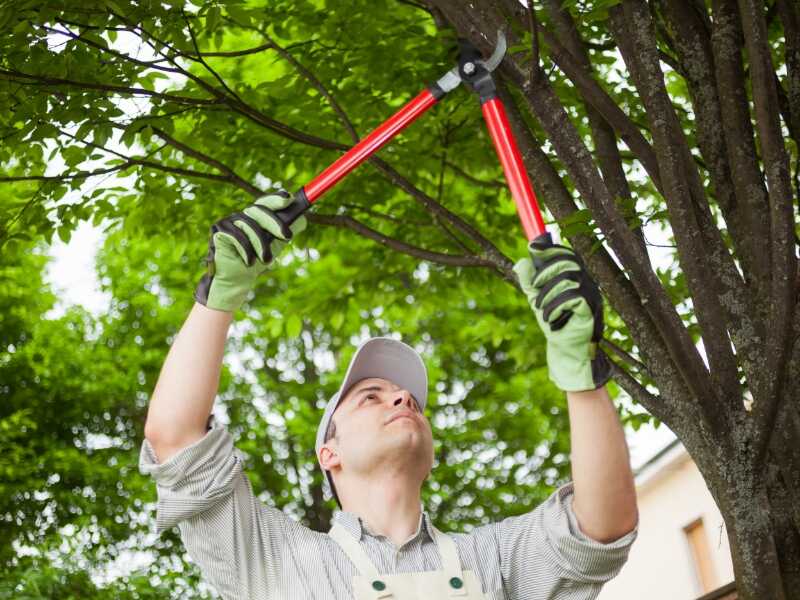
Ideally, your trees and shrubs should have healthy leaves (or needles if evergreen) on the outside and throughout the interior. However, you don’t want the outer surface to be so thick that it inhibits light penetration into the center.
If the sunlight only hits the exterior and can’t reach the middle, it will create a dense outer “shell” but be thin and sparse interiorly. This outer shell also can reduce air movement into the middle, increasing susceptibility to foliar and fungal diseases.
Thinning around the dense interior growth improves sunlight and rain penetration, air circulation, and the plant’s health.
Prune Regularly
Lastly, prune your trees and shrubs regularly — ideally annually — to maintain a desired shape and prevent overgrowth. Maintenance pruning is easier on the plant and reduces the risk of overpruning an out-of-control plant.
When a plant is overgrown, it’s tempting to over prune and cut it all the way back to where you ultimately want the plant to be. However, you should never remove more than 30% of the tree or shrub at one time because it can cause permanent damage. Hence, regular pruning ensures you never need to prune extensively.
Pruning Equipment & Maintenance
As with any other job or DIY project, you must have the right equipment and tools. Although many specialized pruning tools are available, you only need a few essential hand-held pieces to succeed.
Commonly Used Pruning Tools
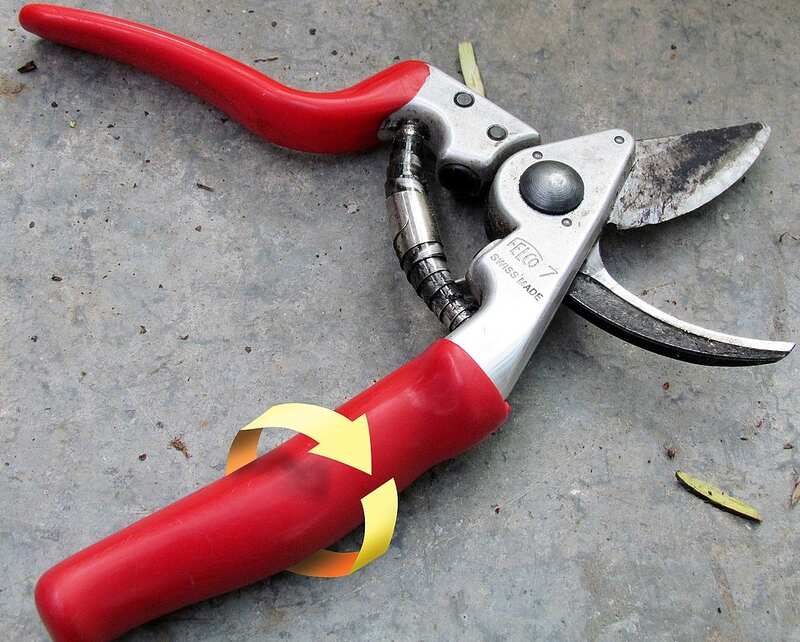
Pruning Shears
Pruning shears are the most common pruning tool. They work well for small-diameter twigs and branches up to about 1.5 inches in diameter. These handheld tools come in two types: scissor and anvil and are available in right- and left-handed models.
- Also known as bypass pruners, scissor-type shears have two cutting blades. Like scissors, the cut is made when the blades bypass one another.
- Anvil-type pruners have a single cutting blade. They cut material when the blade strikes an anvil of solid metal on the other side of the shears.
If you’re looking for new pruning shears, check out our review article on the 10 best pruning shears of 2024.
Lopping Shears
Loppers are similar to pruning shears but are used for branches greater than 1.75 inches in diameter. They have longer handles to provide the leverage needed to cut through these thicker branches. Like pruning shears, they are available as bypass- and anvil types.
Pruning Saws
Pruning saws come in various sizes and types and are used to prune branches and tree limbs larger than 2 or 3 inches in diameter. You can purchase straight or curved blades, narrow blades, and even pole saws that extend your reach for many feet.
Pro Tip: Chainsaws fall into this category and can be helpful tools for pruning large branches and limbs. If you use a chainsaw, always follow safety guidelines and exercise caution.
Pruning Tool Maintenance
Regardless of the type of pruning tool(s) you have, it’s critical to keep it sharp and clean. Sharp tools give a clean, straight cut with minimal damage to the bark and branch tissues. Clean equipment minimizes the spread of any disease-causing organisms that could be present.
- To clean pruning tools, wipe the cutting surfaces with 70% alcohol or a 10% bleach solution (1 part bleach to 9 parts water).
- To sharpen pruning tools, secure the tool in a vise or clamp it to a solid surface. Then, use a metal file to sharpen the blade and remove any nicks or dings.
Pro Tip: Always clean your tools after every use and apply a thin layer of oil to the cutting surface to protect them from rust.
Basic Pruning Techniques for Trees and Shrubs
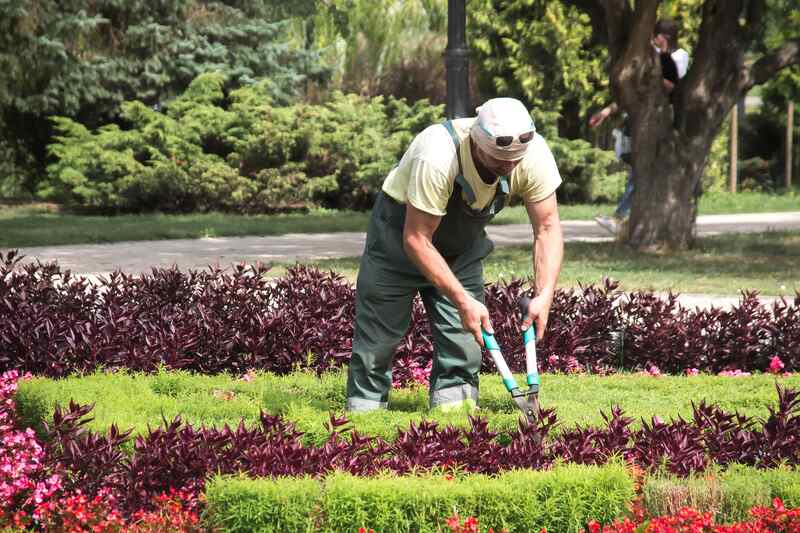
Photo Credit: Pixabay
There are many specialized pruning techniques for specific outcomes. However, the two most basic and valuable methods of pruning are thinning and heading. Thinning helps open the center; heading helps control the size and height. In many cases, the best pruning combines both types.
Regardless of your pruning technique, the ultimate goal is to make the cuts without the tree or shrub looking like it was pruned.
Note: If you need information on training trees, a specialized technique, I have an article on making the first pruning cuts. There’s also an article on the when, why, and how of pruning apple trees.
Thinning Cuts
These cuts remove entire branches, limbs, or shoots. They are made at ground level or the base of the branch to literally “thin” out the center and stimulate vigorous growth of the remaining branches.
When done correctly, the natural shape of the tree or shrub is maintained.
Heading Cuts
These cuts don’t remove entire branches, limbs, or shoots but shorten them. They stimulate the buds on the remaining branch portion to grow, promoting a dense, compact growth habit and reducing the plant’s size or height.
Unlike thinning cuts, heading cuts are used to “shape” the tree or shrub.
Proper Pruning Cuts
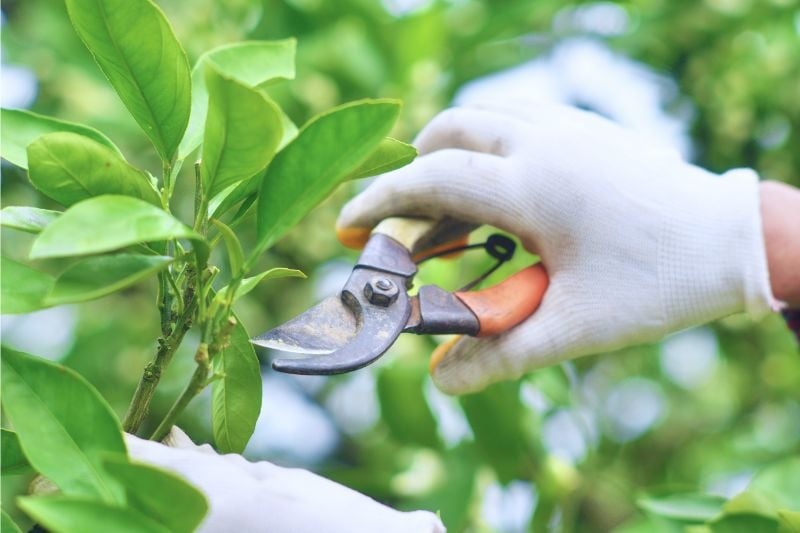
With so many different trees and shrubs used in landscaping, it’s hard to have specific pruning guides for every plant. To provide more in-depth information, we have guides covering the basics: When is the Best Time to Trim, Prune Trees, When to Prune Flowering Shrubs (and How to Do It), Proper Pruning of Your Shrubs, and Pruning 101: How to Trim Bushes, Hedges, and Shrubs.
However, we have articles on pruning lilac bushes and how to prune crape myrtle.
Pruning Small Branches and Twigs
When making pruning cuts on small branches and twigs, three things to consider are the cut angle, the distance to a bud, and the direction the bud faces.
- To optimize the cut’s surface area and healing, always make cuts at a 45º angle.
- Keep cuts about half an inch away from the next bud. Closer cuts can damage the bud and cuts further away leave a too-long stub. In either case, it may inhibit healing.
- Choose inward or outward-facing buds to manipulate the direction of new growth and create a desired shape. If you prune back to an inward-facing bud, new growth will create a denser shape, with branches growing toward the center. If you prune back to an outward-facing bud, it will create a more open shape as new growth moves away from the middle.
Pruning Large or Heavy Branches

Big, heavy branches require a little more care when pruning. When making cuts, use the following three-step process to avoid ripping or tearing the bark and damaging the tree. Often, when homeowners try to use a single cut, the branch’s weight causes the bark to tear down the tree instead of making a clean cut.
- Make a cut on the underside of the limb, about one-third of the way into the branch. It should be about 12 inches to 24 inches from the trunk. This cut will prevent the bark from peeling down the trunk.
- Make a cut on the top of the limb a bit further away from the trunk than the first. The limb’s weight will cause it to break and fall as you cut.
- Make a cut, creating an imaginary diagonal line between the branch collar and the branch bark ridge. Since most of the limb (and weight) is gone, this last cut has little risk of damaging the tree’s bark.
Understanding the Branch Collar and Branch Bark Ridge (BBR)
One of the critical parts of pruning large branches and limbs on a tree is recognizing the branch collar and branch bark ridge (BBR). These key anatomical features are essential to healing and where you make your pruning cuts.
- Branch collar: Swollen trunk tissue that forms around the base of a branch where it connects to the main trunk or stem.
- Branch bark ridge (BBR): Raised bark in the branch crotch where the bark “pinches” as the trunk and branch wood meet.
Inside the area between the branch collar, branch bark ridge, and tree trunk is a narrow group of cells known as the branch defense zone. This cone of cells inhibits the spread of decay or disease into the tree, corralling problems to a single limb or branch. When you make a pruning cut, leaving the branch defense zone in place and cutting just outside or past the BBR is essential.
If you cut too far away from the branch collar, it will leave a stub. If you make a flush cut against the trunk or limb and remove the branch collar, the tree is susceptible to rot or disease.
For more information, Purdue University’s Extension has a landscape report on branch component identification for pruning cuts.
Specialized Pruning Techniques for Hedges
Pruning hedges is a bit more straightforward than tackling trees since there isn’t typically as much focus on the internal structure of the branches.
Regarding pruning hedges, there are two basic pruning methods: formal and informal.
- Formal hedges have a defined, controlled shape and are usually sheared to give them their neat, tight appearance.
- Informal hedges have a more natural look. They are usually pruned into a shape determined by the plant’s natural growth habit.
Regardless of which pruning you’re doing, there are two vital considerations.
- It’s critical to start pruning a hedge the first year it’s planted. Early pruning is necessary to encourage thick, dense growth close to the ground from early on. If hedges are allowed to grow for years without pruning, they may be scraggly at the bottom, and it’s challenging to correct this.
- All hedges should be wider at the bottom than at the top. A triangular shape helps eliminate that twiggy, sparse growth at the base and exposes more of the hedge to sunlight. The upper growth shades out the lower branches if a hedge is top-heavy.
Pruning Needled Evergreens
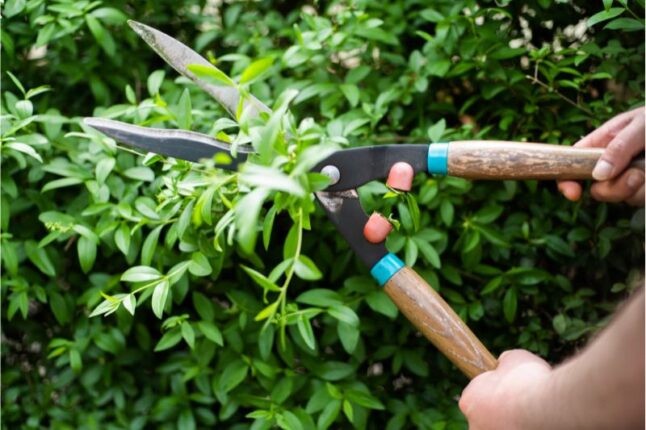
In general, needled evergreens don’t need much pruning other than to keep them from outgrowing their space. However, understand the plant’s branching pattern before hacking away at your tree or shrub. How the branches grow determines how you prune needled evergreens.
- Evergreens with whorled branches have three or more branches or needles originating from the same spot on a stem or limb. Examples include pines, spruces, firs, and Douglas fir.
Whorl-branched evergreens have pre-formed shoots on the end of a branch that expand into stems during one yearly growth flush to form the next whorl. Never prune into the inactive part of the plant beneath the whorls of needles or branches; new branches won’t form. - Evergreens with random branching habits seem to have no rhyme or reason for their growth. Examples include arborvitae, yew, cedar, juniper, and false cypress.
These evergreens have latent buds on the branches that can remain dormant indefinitely and then develop into a shoot when conditions are suitable. This type of evergreen can be pruned back to the wood without needles; new branches will form.
When is the Best Time to Prune?
When it comes to timing, it’s essential to consider why you’re pruning and the type of plant you will prune. Both factors contribute to when you should pull out the shears or saws.
- Dead, damaged, or dying wood can be pruned any time of the year and should be done as soon as it is noticed.
- Spring-flowering trees and shrubs flower on the wood grown the previous season. They should be pruned right after spring blooming to allow them to develop new wood before going dormant for the winter. Examples of spring flowering plants are azalea, lilac, gardenia, rhododendron, magnolia, forsythia, mountain laurel, flowering plum, chokeberry, and flowering quince.
- Summer-flowering trees and shrubs produce flowers on wood (or growth) in the spring of the same growing season. They should be pruned before new growth occurs in spring, so they’re okay to prune in late winter or early spring. Examples of summer-flowering plants are hydrangeas, Rose-of-Sharon, viburnum, snowberry, coralberry, roses, hibiscus, and beautybush.
- Non-flowering trees and shrubs should be pruned in late winter or early spring when they are still dormant. This group includes most deciduous trees and shrubs (elm, oak, maple), many needled evergreens, and some non-flowering broadleaf evergreens like holly and euonymus.
FAQs About Pruning
Is pruning necessary?
Yes, pruning is necessary. While it’s probably one of the most daunting landscape maintenance practices — and one of the least understood — it’s essential to keeping your trees and shrubs healthy and attractive. We put together guides like this so you can know what to do and when to do it.
What happens if you don’t prune trees?
There are many consequences of not pruning your trees and shrubs. First, they might not grow as healthy and robust as plants that are pruned regularly. Second, they may not flower and fruit optimally. Lastly, overgrown trees or trees with dead or damaged branches can pose a risk to your home and property or you and your family.
Should I use pruning sealer?
No, you should avoid using pruning sealer. These sealant products make it harder for a tree to recover after pruning and may trap moisture inside the wound, which can lead to more problems. For more information on why it’s not a good idea to seal your pruning cuts, check out my LawnStarter article, Why Painting on Tree Pruning Sealer Is a Bad Idea.
Need Some Pruning Help?
Pruning trees can be daunting. If you’d rather not take on this task yourself or if tree branches hang out in the overhead power lines, it’s time to hand the tree care over to someone more experienced.
Contact LawnStarter, and we’ll connect you with a local landscape expert who can help with pruning the trees on your property.
Sources
Main Image Credit: virginijavaidakaviaiciene / Canva Pro / License
